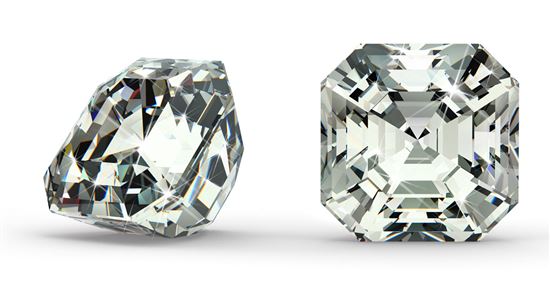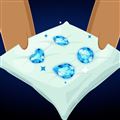Asscher Cut Diamond: What You Need to Know
Get the best asscher cut diamond for your money. Read this to pick the right color, clarity, fluorescence, table percentage and depth percentage.
Asscher Diamond is the Modern Vintage Cut
 |
An asscher cut engagement ring is for the sophisticated girl who enjoys vintage glamour. Learn about this unique cut and how to choose one wisely.
Are you looking for a diamond that will stand out on your beloved's finger?
Consider the asscher - one of the most unique cuts.
Search for Asscher Diamonds
The asscher cut diamond was all the rage in the Art Deco period. Since then, it has tapered off in fame. But in recent years, it has experienced a resurgence in popularity. Nowadays, it's still rare enough that it's a head-turner.
The asscher has a stunning shine. It's a square-shaped, step cut diamond with deep cropped corners, giving it a sophisticated, octagonal shape. The style evokes vintage glamour, but with a modern update.
However, there are a couple of downsides with this cut. Learn about the asscher cut, including tips on making the best purchase for your money.
Recommendations for the Ideal Asscher Cut Diamond
Let's get down to business first. Thinking of buying an asscher cut diamond? Here are our bottom line recommendations:
- Color: H or higher (G or higher for over 1-carat), as yellow tints are more easily revealed
- Clarity: VS2 or higher (VS1 or higher for over 1-carat), as flaws are easily seen with this cut
- Fluorescence: None, as any fluorescence runs a risk of a hazy appearance
- Table percentage: 61% - 68% for maximum light performance
- Depth percentage: 60% - 68% for maximum light performance
Search for Asscher Diamonds
Now read on for the detailed guide to asscher cut diamonds.
7 Things to Know About the Asscher Cut
Is the Asscher just a square emerald?
Yes and no. We'll explain.
The asscher cut was first created by Joseph Asscher in the early 1900s. When it was first created, it was basically a square emerald with 58 facets. However, about a hundred years later and with newer technology, the asscher got an update. The new Royal Asscher Cut was introduced in the early 2000s, with 74 facets for more sparkle.
To revive the cut, the new Royal Asscher Diamond Company was born and created the new Royal Asscher cut in the early 2000s. The modern asscher cut now has a worldwide exclusive patent. A true Royal Asscher will have a laser-inscribed logo and ID number.
So what are the differences between the modern asscher and emerald? The emerald cut has a large, open table and is "flatter" on top. The asscher has a higher crown, a smaller table, larger step facets, and a deeper pavilion. This makes the asscher cut more brilliant than its emerald cousin.
 |
| Asscher Diamond Carat Size Chart © CreditDonkey |
 |
| Emerald Diamond Carat Size Chart © CreditDonkey |
It's a step cut, which gives it a unique shine
Just like its emerald cousin, the asscher is a step cut. This means that the diamond has rectangular facets running parallel to the edges. Visually, the effect is like peering down a hall of mirrors. It doesn't have intense sparkle like a brilliant cut diamond. Instead, the diamond is enjoyed for its beautiful clarity and luster.
But that said, the asscher is still more brilliant than the emerald. So it's great for the girl who loves the vintage look, but wants something a little more sparkly.
Color and clarity are easily revealed
Instead of the multi-faceted surface of brilliant cut diamonds, step cut diamonds have an open table. This allows you see into the depth of the diamond.
As such, any tints of color or flaws are easily seen. Brilliant cut diamonds can get away with lower color and clarity grades, because the light reflecting off of each facet will mask flaws. But you don't get this with step cuts. It's best to choose slightly higher color and clarity grades.
For asscher cut diamonds 1-carat and below, we recommend no less than a color of H and clarity of VS2. For diamonds larger than 1-carat, you'll want to adjust up.
GIA and AGS don't assign a cut grade
Unlike round and princess cuts, the GIA and AGS don't assign a cut grade to asschers. So there's no certification that tells you if it's cut well or not. But we do have some suggestions for ideal proportions for maximum light performance.
| Table Percentage | 61% - 68% |
|---|---|
| Depth Percentage | 60% - 68% |
| Length to Width Ratio | 1 - 1:04 |
| Girdle | Thickness Very Thin - Slightly Thick |
| Cutlet | None |
| Symmetry | Very Good - Excellent |
| Polish | Very Good - Excellent |
It's one of the most expensive fancy cuts
Unfortunately, the asscher cut is one of the pricier fancy cuts. This is because a lot of rough material is lost when making this shape. And only a very skilled jeweler can master this complicated cut, so that also adds to the higher price.
Here's a rough idea of how the asscher cut compares in price to other shapes. We are using 1-carat as the benchmark, color H, and clarity VS2.
- Asscher: $4,500+
- Round: $5,500+
- Princess: $4,000+
- Emerald: $3,500+
- Cushion: $3,500+
And it also has one of the smallest surface areas
Another potential turn-off: it's also notorious for being small when compared to other shapes of the same carat weight. It has a high crown and a large pavilion, which means that a lot of the weight is
contained in the depth.
So how does it compare in size?
 |
| 1 Carat Diamond - Different Shapes Illustrated © CreditDonkey |
The princess cut and asscher cut are both square-shaped diamonds. But the asscher cut has slightly smaller dimensions. It also has cropped corners, which only add to it looking small.
The round diamond is another shape with a reputation of having a small size. Compared to round, the asscher has a smaller surface area - about 10% smaller.
Here are some hard numbers for your use:
| Shape | Surface Area (in mm2) of 1-carat weight |
|---|---|
| Round | 33.18 |
| Princess | 30.25 |
| Asscher | 28.95 |
| Emerald | 31.42 (+/-4%) |
| Oval | 36.00 (+/-5%) |
| Marquise | 38.00 (+/-4%) |
But it's unique and is great for the girl with modern vintage tastes
Despite the downsides, you do get a diamond with a very stunning look. In my opinion, it's one of the most beautiful cuts.
The asscher cut reached its popularity in the Art Deco period. Design and fashion during this period was characterized by bold geometric shapes and intricate details. So this cut looks great in vintage settings. And because the modern asscher has more brilliance, it will shine and stand out on the finger.
A geometric halo setting is gorgeous around an asscher diamond, as it further creates the vintage feel. Tapered baguettes on either side will also beautifully accentuate the center stone. Or just a simple solitaire will allow it to be the star of the show.
One word of caution: stay away from bezel settings, as the metal rim won't let light properly enter the stone.
Other celebrities who have received asscher engagement rings include Gwyneth Paltrow, Zooey Deschanel, Jessica Alba, and Kate Hudson.
Bottom Line
Asscher cut diamonds are still rare enough that they will draw attention and stand out. I love the cut for the old-world glamour it exudes, and also the unique shine it has. It's perfect for the girl who is elegant and classy, but likes to make a statement through her personal style.
Search for Asscher Diamonds
Write to Anna G at feedback@creditdonkey.com. Follow us on Twitter and Facebook for our latest posts.
Note: This website is made possible through financial relationships with some of the products and services mentioned on this site. We may receive compensation if you shop through links in our content. You do not have to use our links, but you help support CreditDonkey if you do.
Read Next:


